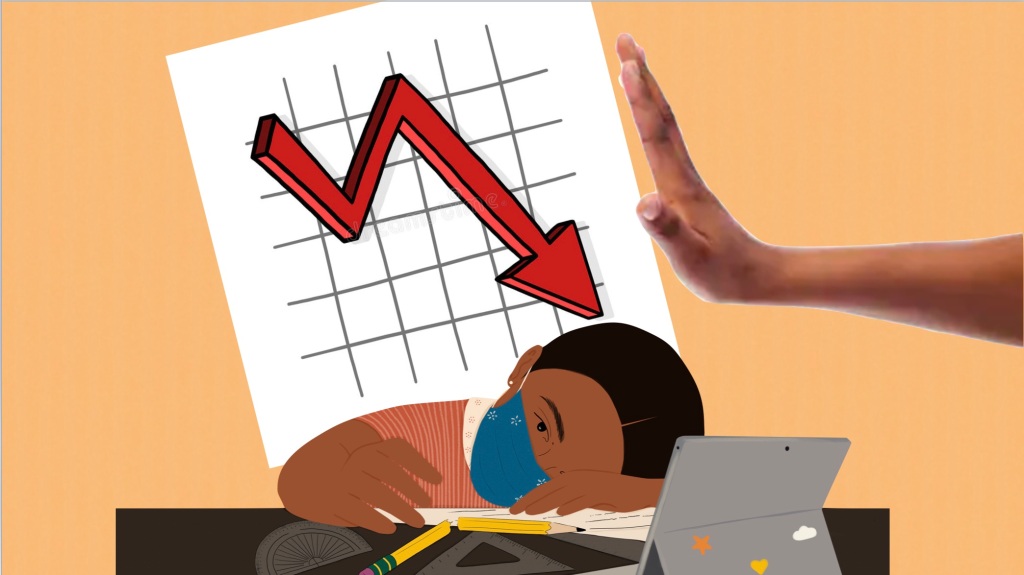
We’ve got to be able to tell how badly the pandemic is affecting student learning.
So let’s give standardized tests.
That’s the rationale behind the Biden administration’s mandate that schools across the country still struggling just to keep buildings open somehow manage to proctor standardized assessments.
Nearly 29 million people have contracted Covid-19 in the United States. More than 514,000 people have died from the virus.
Only about half of the nation’s schools are open for in-person learning, and many of those are operating on a hybrid basis. The rest are completely virtual.
Children have lost parents, siblings, family members, friends, teachers. Families are struggling just to survive with some members still recovering from the longterm health consequences of contracting Covid.
It is absurd to claim that only standardized tests can show whether the pandemic has impacted student learning.
Insisting on testing is like bringing a thermometer into a burning building to tell firefighters where to spray the hose.
But pay attention to the messenger.
In this case, it’s acting education secretary Ian Rosenblum, former executive director of pro-testing organization, the Education Trust.
He sent the letter to state superintendents on behalf of the Biden administration telling them that blanket waivers of the federal testing mandate would not be considered this year as they were in 2019-20.
Let’s be honest. Rosenblum is not an educator.
He is a corporate lobbyist given a government job where he has continued to lobby for his industry.
This has nothing to do with helping students overcome the problems of a pandemic.
It is corporate welfare. Plain and simple.
Standardized testing is a multi-million dollar business.
States spend more than $1.7 billion every year on testing. In 45 states, assessments at the primary level alone cost taxpayers $669 million.
This money isn’t going to mom and pop organizations. The four major testing companies are Wall Street heavy hitters – Harcourt Educational Measurement, CTB McGraw-Hill, Riverside Publishing (a Houghton Mifflin company), and NCS Pearson.
In 2001 the first three agencies accounted for 96% of the tests administered, while Pearson was the leading scoring agency of those tests. And since then the market has exploded.
In 1955 the industry was valued at only $7 million. By 1997 it had ballooned to $263 million. This is a 3ooo% increase. Today the estimated worth of the industry is $700 million.
However, that only takes into account actual assessment.
When you consider that many of these companies (or their parent conglomerates) also provide remedial materials for students who fail the tests, the profits really start rolling in. It’s no coincidence that McGraw-Hill, for example, also publishes books and other materials many of which are used by schools to remediate the same students who fail the company’s tests.
It’s a captive market. The testing company makes and distributes the test (for a fee), scores the test so that a majority fail (for another fee), and then sells schools the materials it claims will help students pass next time (for an even further fee).
However, for the first time in two decades, the pandemic threw a monkey wrench into the machine.
Last year, the Trump administration cancelled all standardized tests as schools were closed to protect students from Covid-19.
Former Education Secretary Betsy DeVos had already signaled that she would not cancel them again this year, but when Trump lost the election, many educators and families had hoped in-coming President Joe Biden would think differently.
He had, in fact, promised that if he were elected he would not continue forcing states to give standardized testing.
I was there at the Education Forum in Pittsburgh in 2020 when my friend Dr. Denisha Jones asked him about it point blank.
You can watch his full answer here, but the crux of it was “Teaching to a standardized test makes no sense.”
Unfortunately, caving to a powerful corporate lobby does. And that’s exactly what Biden has done here.
In fact, it goes a long way to explaining his perplexing rush to reopen schools in his first 100 days regardless of the level of community infection.
Biden, who ran on being friendly to teachers and that his wife Dr. Jill Biden was an educator, has pushed some extremely absurd education policies in his short time in office.
Not only has his administration decided to ignore community infections, he has insisted that schools can be opened safely if districts follow certain safety precautions like universal masking, contact tracing and social distancing.
However, many schools are not following these protocols and even more simply cannot because doing so would be exorbitantly expensive. For example, you can’t have all students return to a cramped school building AND have them be 6 feet apart. There simply isn’t the available space. Moreover, contact tracing doesn’t effectively track Covid cases since most students who contract the virus are asymptomatic.
Then there is the absurd prescription that schools don’t even have to prioritize teachers for the Covid vaccine before reopening. In many states educators aren’t even eligible yet to receive the vaccine. Yet the Biden administration expects them to enter the classroom without necessary protections to keep them, their families and students safe.
These are all perplexing policies until one looks at it from an economic vantage.
Waiting for all teachers to have the opportunity to take a two dose vaccine would take at least a month and a half – that’s if every teacher could start the process today.
In addition, if we wait for community infections of the virus to dissipate, testing season will be far from over. In fact, it’s likely the rest of the school year would be gone.
So if the Biden administration had prioritized safety, it would have been forced to cancel standardized tests again this year.
Instead, it has prioritized the testing-industrial complex.
The economy is more important to the powers that be once again.
As a compromise measure, Biden is allowing flexibility in just about every way the tests are given. They can be shortened. They can be given remotely. They don’t have to be given now – they can be given in the fall.
However, this completely erases any measure of standardization in the processes.
Standardization means conforming to a standard. It means sameness. A test taken by a student at home is not the same as one taken by a student in school. A short version of a test is not the same as a long one. A test taken with 180 days to prepare is not the same as one taken with 250.
And if standardization is not NECESSARY in this case, why can’t we rely on non-standardized assessments teachers are already giving to their students? For example, nearly every teacher gives her students a grade based on the work the child has done. Why isn’t that a good enough measure of student learning?
It’s based on a year’s worth of work, not just a snapshot. It’s in context. And it’s actually more standardized than the hodge podge of assessments the Biden administration is allowing this year.
Why isn’t that allowed?
Because the testing companies won’t make any money.
Moreover, it could ruin their future profits.
If student grades are enough to demonstrate student learning during a pandemic, why aren’t they enough at other times?
The very project of high stakes standardized testing is thrown into question – as it should be.
Educators across the country will tell you how worthless standardized tests are. They’ve been telling people that for decades but policymakers from Republicans to Democrats refuse to listen. It’s almost as if they’re distracted by another sound – the jingle of money perhaps?
Those who claim standardized testing is necessary to determine where students are struggling have the weight of history to overcome.
Standardized assessments were created as a justification of racism and eugenics. They have never shown learning gaps that couldn’t be explained by socio-economics. Impoverished and minority students score poorly on the tests while privileged and white students score well.
If one really wanted to invest more resources where these alleged deficiencies exist, one wouldn’t need standardized assessments. You could just look at the poverty level of the community and the percentage of minority students.
But even more telling is the fact that this has never happened. Testing has never resulted in more resources being provided to needy children other than providing more remedial test prep material purchased from – you guessed it – the testing industry.
Under normal circumstances standardized testing is a scam.
During a pandemic, it’s the most perverse kind of corruption imaginable.
Like this post? You might want to consider becoming a Patreon subscriber. This helps me continue to keep the blog going and get on with this difficult and challenging work.
Plus you get subscriber only extras!
Just CLICK HERE.

I’ve also written a book, “Gadfly on the Wall: A Public School Teacher Speaks Out on Racism and Reform,” now available from Garn Press. Ten percent of the proceeds go to the Badass Teachers Association. Check it out!


















